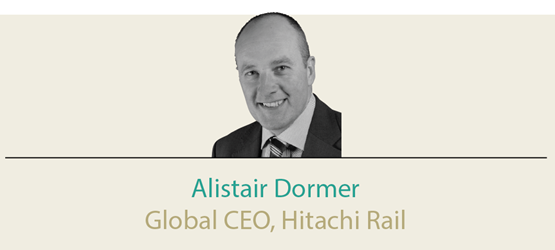
Bi-mode/hybrid technology on trains is quickly becoming the popular answer to the problem of escalating costs of electrification. Partial electrification is being heralded as the most affordable option, but we should clarify what is meant by ‘partial’, as this will drive different bi-mode train requirements.
Let’s say the Midland Main Line is electrified from London to Sheffield, but all the bridges and tunnels are missed - a high speed electric train with a small battery or super-capacitor may then be appropriate. If the electrification is only from London to Kettering, then significantly more energy will need to be carried on board in the form of diesel or hydrogen, to power the train at speed for sustained distances and periods of time.
In this debate we must consider the whole economic case - full electrification reduces journey times, the cost and complexity of the trains (initial capital and ongoing maintenance costs), and emissions, and is the most energy-efficient solution. If we move away from full electrification then we will lose some of these benefits, so the challenge is to get the balance right. Electrification is expensive, but we should consider the full costs of developing and operating bi-modes - for example, what is the true cost of diesel emissions? How much does hydrogen cost to produce, store and distribute? What is the cost of carrying a secondary engine and fuel source around, during periods when it is not needed?
In the near future we will see many more bi-mode trains on our network - the Stadler FLIRT, Hitachi IEP and Porterbrook’s ‘Flex’. In developing Flex, we identified an opportunity for a train that could widen its operation beyond the electrified network. Flex takes an existing electric train and adds a generator that meets the latest environmental standards so it becomes bi-mode. Alternative power sources are being considered for the next Flex fleet. The surplus of electric trains provides opportunities for innovations to meet passenger demand and growth, but this relies on there being a market for re-purposed, existing, good-quality trains within the franchise system.
The environmental case underpinning how UK rail is powered is really important. Moving away from fossil fuels is a necessity - our challenge is whether we can become an emissions-free railway and in what timeframe?
The only bi-mode technology that is available in the UK today for sustained use on main lines relies on diesel. It is interesting to note that electrification schemes are being cancelled at the same time as environmental legislation moves rapidly towards phasing out diesel engines in cars. And let’s not forget freight - each freight train takes a significant number of lorries off our congested roads. But freight trains often need high power to pull long, heavy trains, and many of the distribution centres are not electrified - so how do we develop these newer technologies to work for freight?
Emerging bi-mode technology needs to match the infrastructure (shorter or longer areas without electrification). We need to ensure the long-term infrastructure plan and rolling stock plans are aligned so that we specify the right train today for the long term, otherwise we risk replacing or modifying trains too early, which increases the total cost of the system. There is definitely a growing role for bi-mode trains in UK rail’s future plans, but the technology choice must match the infrastructure.

The UK Government’s latest electrification announcement requires the industry to think about the future without a full set of wires overhead.
Clearly, bi-mode solutions are currently firmly in the driver’s seat. Converting 21 solely electric Hitachi IEP trains to electro-diesel units for the Great Western route hasn’t been without its challenges, but passengers along the full length of the line will experience brand new trains with more seats from the autumn, rather than at an unspecified date in the future. Nevertheless, it is right that the industry considers how to make the best of a partially electrified network, and how both alternative fuels and new railway system technologies can add to this.
In this debate, there’s a tendency to fixate on the need for speed. Given Hitachi has been building very high-speed since 1964 (and with Javelin launching Britain’s HS1 line in 2009), we understand speed and its benefits. Yet the reality is Britain’s overcrowded railways need new trains with more capacity quickly. Hitachi’s bi-modes and HS2’s trains will both deliver journey time savings, but the key driver for both projects is the step-change in capacity they offer.
Where the Government and Network Rail can still make the case for electrification, we can’t overlook that there has to be sufficient available electrified track on which to test new trains, whether electro-diesel or electric-only. Without this, manufacturers and their customers will continue to have to test in Europe, and to carefully manage expectations around delivery and (ultimately) introducing new passenger timetables.
As for alternative technologies, Hitachi sees great potential in batteries. Our V-train 2, which was tested in the UK in 2007 using hybrid battery/diesel power and regenerative charging, was the world’s first high-speed hybrid train. Hitachi went on to launch the DENCHA train in Japan in 2016, running primarily on OLE, but with a battery that is able to carry it a further 40km off the wires. Crucially, battery power offers the ability to run EMUs to lines that haven’t been fully electrified, thereby better linking communities while having less environmental impact.
Historically, the challenge with batteries has been their cost, weight and length of charge, limiting their use to shorter distances. However, the technology is advancing, with the driver of innovation likely to be the automotive industry, with its greater economies of scale.
Beyond the questions of fuel and the ‘need for speed,’ passengers’ experience of the railway is being transformed as we realise the potential in digital technologies. Dynamic headway, for example, adapts train services to real-time demand, which increases utilisation and passenger satisfaction while saving on energy.
It is clear that in the longer term we will be burning less diesel. Pure electric trains offer many benefits, but Network Rail has to value-engineer the infrastructure to make installation more affordable. New technologies are advancing quickly, but until a single, superior technology becomes obvious, picking winners today is precarious. For now, we have to be open to innovations and the upsides they offer.











